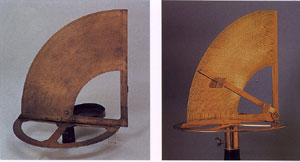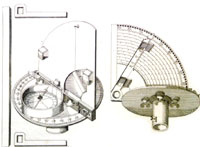|
An unforeseen event makes history
When what had been said until now corresponded in general terms to all that we knew at the time about this matter, something unforeseen happened. We were in New York and decided to visit the Hayden Planetarium. We did it because we believed that, in keeping with its counterpart in Chicago, the owner of the most important collection of scientific instruments in the United States, it might contain some objects of interest to us. And it did!
In fact, due to an amazing coincidence – could this be the so-called serendipity? – the company IBM was holding an exhibition of replicas of scientific instruments of the past. Among them we came across Galileo's Proportional Compass, on display in a beautiful showcase. This was a quadrant containing the nonius. Its legend indicated that the original, manufactured by Galileo in approximately 1597, was a result of improvements made to similar devices. Although erroneous, the legend further informed that "This replica is based upon an original Galilean Compass in the Museum of History of Science in Florence". If this were true, we would have found the first instrument of that period containing the nonius of Pedro Nunes.
As this was a Sunday and we were returning to Lisbon the next day, we wrote to the Planetarium of New York from here, asking for a photograph of the referred replica and for the identification of the original in the Museum in Florence. After some time we received, not from the Planetarium but from IBM, via Amsterdam, a catalogue on an exhibition of Leonardo da Vinci, with no explanation whatsoever and which naturally had nothing to do with the subject.
 |
|
|
|
|
(click on the picture above to see an enlarged version)
Picture on the left – Quadrant fabricated by James Kynuyn in 1595, as indicated in the catalogue of the Institute and Museum of History of Science of Florence. It is possible the only instrument that exists containing the nonius of Pedro Nunes.
Picture on the right – Reconstitution of the quadrant containing the nonius of Pedro Nunes, which exists in the Istituto e Museo di Storia della Scienza of Florence.
|
|
|
|
In view of this situation, we decided to ask the Institute and Museum of History of Science of Florence, where the legend placed Galileo's Proportional Compass, in order to obtain the data vital for our study. In response we received a photograph of a simple proportional compass.
As we believed the confusion lay not in the instrument but rather in its identification, we decided to speak directly to Mara Miniati, the curator of this prestigious museum and whom we know well, as she is a member, just like us, of the Scientific Instrument Society of London. We told her what we were looking for and, as a result of her diligence, we received a photograph of an instrument containing the nonius, but which most certainly had nothing to do with the replica in New York.
It is a quadrant used for measuring altitudes but which does not contain an alidade. The graduated horizontal limb on which the quadrant rests is somewhat damaged and the stand for the compass is missing. Nevertheless, the nonius, which is what most interests us, is in perfect condition and reproduces exactly what was designed by Pedro Nunes.
The producer of this instrument, James Kynuyn, was active in London between 1569 and 1610 and his name was written in several ways. The production date of this instrument, as stated in the Museum’s catalogue, is 1595, however, in its description no mention whatsoever is made to the nonius, which indicates that the work of Pedro Nunes is not known abroad, unlike what used to happen in the past.
We were naturally very pleased with the discovery of Kynuyn’s instrument, as it was the first specimen, and perhaps the only one, that incorporated the famous invention of the nonius. We therefore believe that this matter is of utmost interest to the History of Science.
One of the most fascinating aspects of historical research is precisely to discover the path followed by works of science or of art from the moment in which they are produced until they reach a museum, which is without a doubt their natural destiny. To find out the name of the person or persons who ordered them and of the manufacturer who produced them, of those that owned it throughout time, the prices paid for them and the repairs they underwent is an objective that the researcher is not always able to achieve. It is like moving backwards in a time machine, yet the machine more often than not jams. Nevertheless, in this case it worked.
We were able to find out that the quadrant in question belonged to Robert Dudley, who also owned other scientific instruments, which he took to Italy.
|
 |
|
|
|
(click on the picture above to see an enlarged version)
Illustration presented by Robert Dudley in Dell’Arcano del Mare, edited in 1646-7, which reproduces Kynuyn’s quadrant, before having lost the alidade and the compass.
|
|
|
Robert Dudley (1573-1649), the duke of Northumberland, was the son of the count of Leicester, who was minister and the favourite of Elisabeth I of England and of Lady Douglas Sheffield.
Sir Robert had a troubled life. He was a student at Christ Church, Oxford and in 1594, at the age of 21, he became the captain of two ships that travelled to the West Indies and to Guiana. In this mission he explored the mouths of the river Orinoco, in the territory that is today Venezuela. Two years later, he participated in the navy expedition to Cadiz, having been knighted for his bravery. The fact that he was an illegitimate son brought him complications and in 1605 he left England for good with one of the beauties of that period, Elizabeth Southwell, leaving his wife and children behind. He established himself in Florence, converted to Catholicism, married Elizabeth and for all this had his possessions confiscated and sold.
In his adopted country, he was taken in by Cosimo II (1590-1621), the grand duke of Tuscany, and later continued at the service of his successor Ferdinand II (1610-1670), a disciple of the great Galileo, who was very interested in the arts and sciences.
Robert Dudley was a geographer and naval engineer, having designed and constructed ships for the Medici, receiving in exchange the protection of these great lords of Florence. He drained the swamplands between Pisa and Leghorn and built the seaport that serves the latter. As a demonstration of his knowledge, he published at the end of his life, in 1646-7, Dell'Arcano del Mare, a treaty made up of five parts complied in three volumes, which he dedicated to the grand duke Ferdinand. A copy of this work, of beautiful graphic aspect and containing exquisite illustrations, can be found in the Biblioteca da Ajuda. It contains several issues related to things of the sea, such as a treaty on naval strategy, a naval construction manual, guidelines for the construction of coastal fortifications, instructions for navigators and a collection of world maps, to mention only what is most important in this exceptional work. In part V, dedicated to navigation and nautical instruments, there is an illustration of singular interest, as it reproduces Kynuyn’s instrument which, as we referred above, is incomplete.
After Dudley’s death, this quadrant along with other instruments of his became the property of the grand duke and shortly afterwards started a journey around Florence. In fact, in 1654, the collection passed to the Galleria degli Uffizi, where it remained until it was integrated in the Museum of Physics and Natural History, between 1769 and 1775. In 1930, after the creation of the Institute and Museum of History of Science, it was finally deposited here. It is curious to note that this museum contains a nautical astrolabe manufactured by the Portuguese Francisco de Goes.Rapozo, with the date 1608, and which originally belonged to Dudley.
Now that our Florentine investigation was over, we decided to once again turn to the New York mystery. Through IBM in Lisbon we were able to obtain a Polaroid photograph of the replica which we saw at the exhibition of the Hayden Planetarium and which now decorates the office of the chairman of IBM, New York.
Despite its poor definition, the photograph enables us to verify that the alleged replica was in fact an exact copy of one of the quadrants used by Tycho Brahe and included in his work Astronomiae Instauratae Mechanica, mentioned above. We are therefore faced with one of the following three situations:
1. The replica is a copy of Tycho Brahe’s original. In spite of all the information we have and which strongly suggests that the instruments of this astronomer disappeared, we cannot abandon this lead;
2. The replica is a copy of a replica of a quadrant belonging to this famous astronomer. In this case, it would be very interesting to discover its whereabouts;
3. The replica was copied from the drawing included in the referred work of Brahe.
While looking for news ways of clearing up this issue, as we had already lost hope of ever receiving a reply to our letters addressed to IBM, we received a missive from the Office of IBM Director of Brand Management, Corporate Communications of this highly regarded firm, which reads as follows:
"November 15, 1994
Dear Mr dos Reis
I am responding to your letter to IBM concerning the Galileo Proportional Compass.
The Compass is no longer on public exhibition, or available for inspection.
I regret that we cannot be more helpful in your studies.
Sincerely,
Charles E. Pankenier"
With this reply, this avenue was unfortunately and unpleasantly closed, as it is perfectly clear that IBM does not intend to make any effort to unveil the truth. All this leads us to believe that this position is aimed simply at covering up the error committed, which we in fact believe is not of IBM’s responsibility. It seems to be the norm for firms to hire companies providing special services, as in the case of IBM, to organise and set up exhibitions.
Nevertheless, although it may seem difficult to believe and with no form of humour intended, we are in fact very grateful to IBM and to the author of the false legend for, unsuspectingly, leading us to the museum in Florence, in which Mara Miniati, to whom we are profoundly grateful, identified the only existing nonius of Pedro Nunes.
|
|



